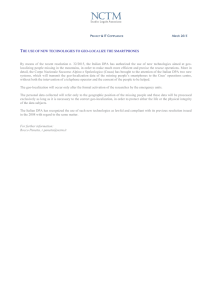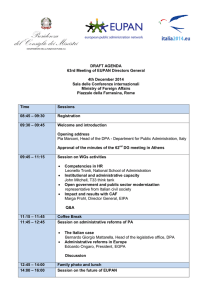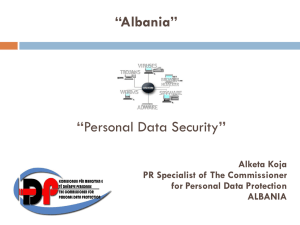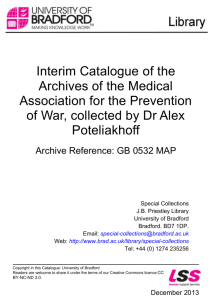Communications protocol - Pilbara Ports Authority
advertisement
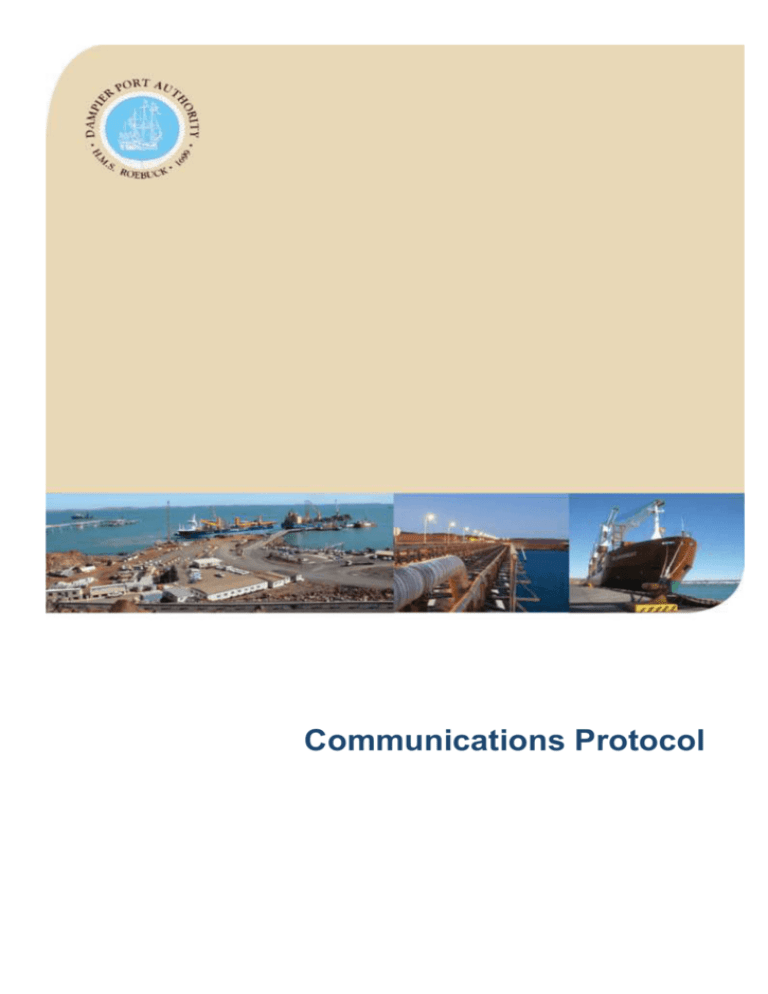
Communications Protocol Communications Protocol 1. PURPOSE AND SCOPE ....................................................................................................... 3 2. RELEVANT DOCUMENTS .................................................................................................... 3 3. COMMUNICATION AGREEMENT ........................................................................................ 3 4. CONTACTS ........................................................................................................................... 4 4.1. DPA PERSONNEL ................................................................................................................ 4 4.2. PROPONENT PERSONNEL ................................................................................................. 4 5. PROTOCOL .......................................................................................................................... 5 5.1. GENERAL INFORMATION/QUERIES ................................................................................... 5 5.2. EMERGENCY COMMUNICATION ........................................................................................ 5 5.3. MEETING COMMUNICATION............................................................................................... 5 5.4. FORMAL CORRESPONDENCE............................................................................................ 5 5.5. PROTOCOL........................................................................................................................... 6 5.6. TECHNICAL QUERIES/CORRESPONDENCE ..................................................................... 6 5.7. EMERGENCY RESPONSE REPORTING ............................................................................. 6 5.8. ENVIRONMENTAL REPORTING .......................................................................................... 6 5.9. DEVELOPMENT AND CONSTRUCTION APPLICATION NON CONFORMENCE ................ 7 6. A163040 ISSUE RESOLUTION............................................................................................................ 7 Page: 2 of 7 Communications Protocol 1. PURPOSE AND SCOPE The purpose of this document is to formalise a Communications Protocol between Dampier Port Authority (DPA), and the Proponent during the Development Application and Construction phases of the proposed project. A separate communication protocol may be developed for each lead contractor if required. The document defines the mechanism for the transmission of formal communications of reliable information by the identified stakeholders in a timely and efficient manner without duplication of effort between the parties. This protocol applies to communications in both directions between the DPA and the Proponent. The Proponent will be responsible for ensuring that all its direct reports and subcontractors are aware and follow the relevant procedures and understand their application. Others not directly identified by this protocol should engage the DPA only as noted in Section 5.0 following the related protocol. 2. RELEVANT DOCUMENTS Development Approval Application Form Construction Approval Application Form Proof of Engineering Certificate Port Development Guidelines Application for Modification Works 3. COMMUNICATION AGREEMENT DPA and the Proponent will communicate in an appropriate manner (either oral or written) through the established lines and channels of communication outlined in this Communications Protocol. DPA and the proponent will observe the terms and conditions of any applicable confidentiality agreement. Where other parties not directly subject to the applicable confidentiality agreement require to transmit any project related information to stakeholders not identified under this protocol, prior permission shall be obtained from the party who has ownership of any proprietary or confidential information before it is released. A163040 Page: 3 of 7 Communications Protocol 4. CONTACTS 4.1. DPA PERSONNEL Role Responsibility Contact Details Director, Strategy & Development All formal correspondence relating to the Development Application & process Responsible for ensuring that all direct reports are aware of this procedure and its application. Escalated situations. TBA P: M: E: Project Manager All general correspondence outside the Development Application. Onsite construction related activities. Monthly meetings. Fortnightly reports. TBA P: M: E: Harbour Master Maritime operational activities. Environmental incident reporting. Port security issues. Notices in relation to Port operations/activities. Emergency and cyclone management. Mr Gavin Giblett P: +618 9159 6565 M: +61 409 205 775 E: gavin.giblett@dpa.wa.gov.au TBA Project Administrator Nominated communications officer for the Wheatstone project. Responsible for the implementation and continuous improvement of this procedure. Payment of Development Application invoices. E: accounts@dpa.wa.gov.au Accounts Payable 4.2. E:projectadmin@dpa.wa.gov.au Payment of invoices for services and fees. PROPONENT PERSONNEL Role Responsibility Contact Details Project Execution Manager (or similar) Escalated situations in relation to Project Development [Insert name and contact details] Permits and Compliance Manager Matters in relation to permitting and compliance of Development Application(s) [Insert name and contact details] Project Engineer Matters in relation to Development Application(s) [Insert name and contact details] Document Controller (or similar) Nominated communications officer for the project [Insert name and contact details] Accounts Payable Payment of Development Application invoices [Insert name and contact details] A163040 Page: 4 of 7 Communications Protocol 5. PROTOCOL 5.1. GENERAL INFORMATION/QUERIES All formal communications should be raised to the appropriate contact as noted in Section 4 with a copy CCed to the Project Administrator. Forms and templates for information exchange shall be approved by the DPA on a case by case basis. The party raising the initial communication should maintain records of all correspondence sent and received. Unless otherwise, the nominal turn around period for a response to a request for information shall be taken as ten (10) working days. If it is not clear who has direct responsibility for the matter of inquiry then contact the DPA’s Project Administrator. The project administrator will refer the matter to the appropriate DPA staff member if it goes beyond their role. 5.2. EMERGENCY COMMUNICATION During the construction phase, communications relating to emergency or crisis shall follow the procedures outlined under the Memorandum of Understanding for Emergency Response between the proponent and the DPA. 5.3. MEETING COMMUNICATION Where formal meetings are held, it is expected that an Agenda will be issued at least five (5) working days before the scheduled date, insofar as practical. In the event this is not achievable, both parties will ensure an Agenda is issued prior to the meeting date (ideally at least 24 hours in advance); the meeting should follow the agenda specifically. Any new issues arising from the initial meeting should be captured as actions to be addressed under the Agenda of a follow up meeting as required. The notification that a formal meeting should be held shall be raised electronically via e-mail calendar requests. Requests shall include as base minimum the list of participants and agenda. Meeting notes should not record unnecessary conversational dialogue; notes shall record only decisions and actions resulting from the meeting agenda. The party hosting the meeting is required to keep minutes of meetings and forward them through to the other party within five (5) working days. 5.4. FORMAL CORRESPONDENCE Formal written correspondence should be raised whenever an exchange of information is required to seek an official response from a receiving party in relation to any project related matters. The preferred mode of formal information transfer or correspondence between DPA and the Proponent is by way of letter issued under hard copy correspondence. Correspondence issued in this manner is understood to represent controlled and reliable information reflecting the position of the transmitting party. The content of electronic correspondence (email) is representative only of the understanding of the person sending the email. Formal correspondence can be included as an attachment to the email delivering the correspondence but must be backed up with a delivered hardcopy. The formal correspondence should use an approved correspondence form, with provision for numbering and revision control. A163040 Page: 5 of 7 Communications Protocol 5.5. PROTOCOL Where a correspondent requires an answer to a specific question(s), the question(s) should as far as possible conform to the following principles: Questions should relate to a single subject. If multiple subjects are required to be raised, separate information request correspondences should be made to cover grouped subject matter. Clear and definite question(s) should be raised; responses should address specifically the questions raised. Attachments relating to the query should be easily accessible for review and where possible included in the query submittal for review. The response time from the receiving party should be ten (10) working days from issue of the correspondence. Only the party raising the correspondence can close the correspondence. Revision control of the outgoing correspondence is the responsibility of the issuing party. Where the intent of a correspondence is to state a position or to inform the recipient of new information and no response is required, the issuer of the correspondence should raise the correspondence as “Closed” upon issue. Emergency or crisis communications should be handled directly as noted in Section 5.2. 5.6. TECHNICAL QUERIES/CORRESPONDENCE The Proponent shall agree a protocol with the DPA for raising and responding to technical queries. 5.7. EMERGENCY RESPONSE REPORTING The Proponent has responsibility and accountability for its own emergency procedures within the Port, whilst satisfying the DPA that approved procedures are in place and are being followed. The Proponent is required to submit regular incident and audit reports which assist the DPA in meeting its statutory responsibilities for maintaining a safe and efficient Port. All reports must be sent to the DPA’s Harbour Master and copied to the DPA’s Project Administrator as noted in Section 5.4. 5.8. ENVIRONMENTAL REPORTING The Proponent has responsibility and accountability for its own environmental procedures within the Port, whilst satisfying the DPA that approved procedures are in place and are being followed. The Proponent is required to submit incident and audit reports to assist the DPA in meeting its statutory responsibilities to protect and manage the environment from the commercial activities operating within the Port. All Environmental Reporting and liaison must be directed to DPA’s Environment and Heritage Manager and copied to the DPA’s Project Administrator as noted in Section 5.4. A163040 Page: 6 of 7 Communications Protocol 5.9. DEVELOPMENT AND CONSTRUCTION APPLICATION NON CONFORMENCE In the event that a non-conformance is raised, the DPA may issue a stop order. This stop order will be communicated immediately to the Proponent’s nominated representative by the DPA. This stop order will also follow the formal communication protocol and will be communicated immediately by e-mail as well as hardcopy delivery. Upon receipt of the stop order, the Proponent’s representative shall instruct the concerned area to stop work immediately until resolve can be reached. The Proponent must provide the DPA with satisfactory evidence of its plan to rectify the non-conformance and how it will avoid further issues in future works of a similar nature before the stop order will be lifted. 6. ISSUE RESOLUTION In the event there is a communication breakdown and/or an issue cannot be resolved in a timely and adequate manner, both parties have the right to escalate an issue to the next highest level within their own respective organisations. A163040 Page: 7 of 7

